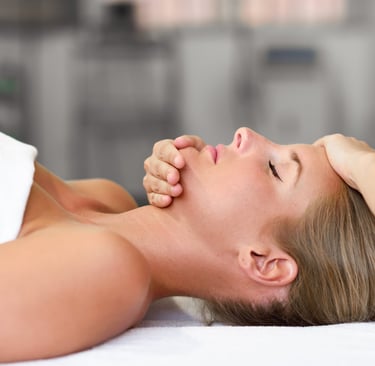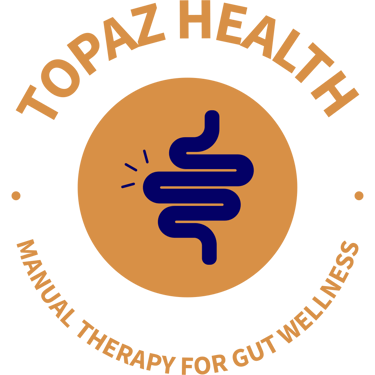Osteopathy Treatment for Jaw Pain &
TMJ Dysfunction
What is the TMJ?
The temporomandibular joint (TMJ) is a complex joint that connects the jawbone to the skull. It is located just in front of the ear on either side of the head. It allows you to talk, chew, yawn and open and close your mouth with ease. The TMJ consists of cartilage and a small disc that cushions the joint, enabling smooth motion. This complex joint includes a small disc and layer of cartilage that cushion movement, while several key muscles — the temporalis, masseter, and pterygoid muscles — help control motion and stability.
When the TMJ isn’t functioning well, it can cause pain, tension, and difficulty moving the jaw, often impacting eating, speaking, and general comfort, significantly affecting quality of life.
What is TMD?
Temporomandibular dysfunction (TMD) refers to a group of conditions affecting the jaw joint and surrounding muscles.
Common signs of TMD include:
Pain or tenderness in the joint
Pain or tenderness in the jaw
Face pain or tenderness
Ear pain where no infection or other pathology is present
Pain with chewing or yawning
Pain or difficulty swallowing
Headaches, especially temple headaches
Limited mouth opening or difficulty opening and closing the mouth
Popping or clicking sounds in the joint in addition to pain or dysfunction
Crunching sounds in the joint
Jaw locking
Neck and shoulder pain and tension
TMD can result from several factors — including teeth grinding (bruxism), stress or anxiety, jaw clenching, dental alignment issues, or injury to the face, head or neck.
Potential causes or drivers of TMD?
Causes of TMD are often multifactorial and it is still unclear what really causes TMD. Common contributing factors are as follows:
Bruxism (clenching or grinding the teeth)
Stress which can exacerbate jaw tension
Trauma to the face, head or neck, e.g. whiplash
Dental issues e.g. malocclusion, poor fitting splints/appliances
Excessive chewing of gum or habits like nail biting
TMD is more common in women, potentially due to hormonal influences such as oestrogen receptors in the TMJ. Some studies have found associations between TMD, sleep apnoea, and acid reflux. (1, 2, 3).
How may osteopathy help?
Osteopathic treatment aims to reduce pain, improve jaw mobility, and restore function throughout the head, neck, and shoulders. Treatment is always holistic, considering how other areas of the body may contribute to jaw dysfunction. For example, if reflux or poor posture is also present, the diaphragm and viscera may be assessed and treated to improve overall outcomes.
Techniques may include:
Soft-tissue massage to the jaw, neck, and shoulders
Joint mobilisation to restore movement
Intraoral techniques (inside the mouth) to release tension safely and gently
Only techniques you’re comfortable with will be used, and you may be referred to your dentist or GP if appropriate. You will also receive individualised self-care advice and exercises to support your recovery and prevent future flare-ups.
Self-help tips for TMD
Apply a warm compress or an ice pack to the jaw area
Avoid chewing hard foods like apples and nuts
Avoid chewing gum, your pens and biting your nails
Avoid placing your hand under your chin or sleeping with your hand under your face
Be aware of when you are grinding or clenching
Find ways to manage your stress
Self-massage for the jaw muscles
Neck stretches
TMJ exercises can be helpful in later stages when you are in less pain. Resting the jaw in the initial stages is best.


References
Wang, Y. P., Wei, H. X., Hu, Y. Y., & Niu, Y. M. (2024). Causal Relationship Between Obstructive Sleep Apnea and Temporomandibular Disorders: A Bidirectional Mendelian Randomization Analysis. Nature and Science of Sleep, 16, 1045–1052. https://doi.org/10.2147/NSS.S476277
Wu, J.-H.; Lee, K.-T.; Kuo, C.-Y.; Cheng, C.-H.; Chiu, J.-Y.; Hung, J.-Y.; Hsu, C.-Y.; Tsai, M.-J. The Association between Temporomandibular Disorder and Sleep Apnea—A Nationwide Population-Based Cohort Study. Int. J. Environ. Res. Public Health 2020, 17, 6311. https://doi.org/10.3390/ijerph17176311
Bartley J. R. (2019). Gastroesophageal reflux disease, temporomandibular disorders and dysfunctional breathing. CMAJ : Canadian Medical Association journal = journal de l'Association medicale canadienne, 191(45), E1255. https://doi.org/10.1503/cmaj.73545
Designed by Freepik
Contact
The Body Project
Level 4,6 Help Street
Chatswood
NSW, 2067
(02) 9884 8758
fiona@topazhealth.au
Quick Links
FAQs
Osteopathy for Gut Health
Osteopathy for TMJ
Fees
Resources
Copyright © 2024 | Topaz Health | Privacy Policy | ABN: 141 202 953 15


Blues Point Practice
117 Blues Point Road
North Sydney
NSW, 2060
0422713396
You Little Beauty
Shop 7, 33 Tramore Place
Killarney Heights
NSW, 2087
0422713396
